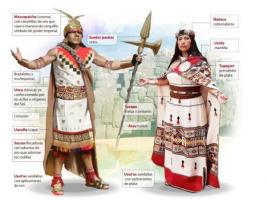What are the 5 AGES of history?

Do you want to know what the ages of history are? Scholars have divided all knowledge about humanity into different stages that span broad periods of time and that change when an important or determining event takes place for the direction of the story. The historical stages that are part of the history of humanity are: Prehistory, the Ancient Age, the Middle Ages, the Modern Age and the Contemporary Age.
Five periods in which people have evolved from living in caves and caves to our days, living in big cities, using a means of communication like the Internet and living an average of 80 years. In this lesson from a teacher we are going to do a easy summary of the ages of history and we will also indicate the characteristics of each of these stages.
Index
- What are the five stages of history?
- Prehistory: stages and characteristics
- The Ancient Age: main characteristics
- The Middle Ages: Short Summary
- The Modern Age: Main Features
- The Contemporary Age: Main Characteristics
- Timeline of the ages of history
What are the five stages of history?
To know what are the ages of historyBefore, we must understand what we mean when we talk about history because, in this way, we will understand why being human has had to divide all the time lived as a species and that is organized according to some progress or progress.
In order to define what history is we will say that it is el study of past events and the evolution of human life on the planet. History is intended to study where we come from, what were the first humans and the forms of life that populated the planet long before our generation.
The history of mankind is very long and, in fact, we must go back in time for several million years to be able to find the first traces of humans on the planet. The organization of history is always carried out under a chronological order, that is, it starts from the very ancient to the most recent in order to understand all of life in its magnitude and understand the origins of our reality.
The way in which Western culture has divided history has religious roots: the birth of Christ is our starting point. Therefore, any date to which we refer and that is after this fact, is indicated with the addition to. C. (before Christ) and if it happened after, add d. C. (after Christ).
The stages of universal history
Thus, the historians of the West determined that our history is divided into different differentiated periods or that have meant a significant change in the way of life or conception of the reality.
In summary, the ages of the story are as follows:
- Prehistory: from the origin of mankind (that is, about 2 or 3 million years ago. C.) until writing was invented (four thousand years BC. C.)
- Old age: begins with the appearance of writing and ends with the fall of the Roman Empire (in the 5th century AD). C.)
- Middle Ages: from the 5th century until the Spanish discovered America, in the 15th century (specifically, in the year 1492).
- Modern age: from the XV until the French Revolution begins.
- Contemporary age: from the XIX to the present.
Image source: IHMC Public Cmaps
Prehistory: stages and characteristics.
Then we are going to analyze the ages of history in a characteristic way so that you have a slight idea of what took place in each stage and, thus, understand where we come from as a species but also as a civilization. And the beginning of all this is in Prehistory, that is, the events that are more distant from our present time and that coincide with the appearance of the first hominids 2 or 3 million years ago, the precise date is unknown.
From the appearance of the first hominid and until that of Homo Sapiens (the first ancestor of the human being) the species was evolving and perfecting both building more precise tools, and organizing to live in community.
What is Prehistory
The time that we gather under the label of "Prehistory" is the longest of any other historical period since it covers from the first hominid appeared until the writing was invented. An evolution that took many years and that, for this reason, researchers have had to divide in order to better understand the events and improvements that took place at this time; thus, the stages of prehistory are as follows:
The Paleolithic
At this historical moment we we found the first humans who fed on hunting, fishing and gathering fruits. They created tools manually with everyday materials and that were in their environment (such as bones, stones, wood, etc.) to be able to hunt and, thus, feed themselves. They were grouped in small groups and had no fixed residence, so they were nomads who took shelter inside the caves.
During this period, they managed to master fire, one of the most outstanding achievements since it allowed them to cook food, warm up and light up at night. One of the most outstanding aspects of this period in history is the Palaeolithic art, that is, the cave paintings with which they recorded their way of life.
In this other lesson from a teacher we will discover the characteristics of Prehistory in the Paleolithic for you to go even deeper into this topic.
The Neolithic
The passage from one stage to another is given because humans begin to produce their own foodIn other words, agriculture and livestock began, something that led to great changes in the way of life of the groups. First of all, they had to contrive to create new tools that would serve to In the field, in the same way, food is now being stored, which is why ceramics are started.
Another of the most notable changes of this period is that people stopped being nomads to become groups sedentary because, now, they no longer had to move to look for their food but they themselves were capable of producing it. With this they begin to create the first villages in which families and members of the same tribe coexist.
In a teacher we also explain to you in this other lesson all about theNeolithic in a short summaryso that it is easy for you to study and delve into this stage of Prehistory.

Image: Slideshare
The Ancient Age: main characteristics.
We continue through the ages of history to meet the period that History inaugurates, that is, the period in which Christ will be born and that, therefore, we will start counting from scratch. But the Ancient Age begins before Christ, in fact, 3300 years before his birth and the reason why the time is changed is because writing arises. This is a crucial event in the history of mankind and, for this reason, the experts marked the beginning of a new era here.
It is in this historical period that the first civilizations on the planet develop, most of which are dedicated to agriculture and livestock.
Mesopotamia
They settled in the northern Arabian Peninsula and they date from the year 4000 a. C. and to them we owe the invention of the agricultural irrigation system. The empire was divided hierarchically as a City-State in which the royal family and the clergy were in the highest parts of the pyramid and the artisans or peasants in the last link.
The religion they professed was polytheistic and from their culture we have been left with sciences as important as the astronomy or the four artimetic rules of mathematics. His writing method was pictographic and hieroglyphic and, from them, works such as "The poem of creation" or "The Epic of Gilgamesh" have come down to us. In this other lesson we discover a overview of Ancient Mesopotamia.
Egypt
They lived in the north of Africa, near the Nile and its origins date back to 3300 a. C. Egyptian society was also highly hierarchical and the sovereigns of the people were known as "pharaohs", people that they were considered divine and that they had absolute control of the administrative, judicial, military and religious. In this other lesson you will discover the characteristics of Egyptian civilization.
The religion of Ancient Egypt is a great cultural legacy that has survived to the present day and, Thanks to it, we can currently enjoy one of the seven wonders of the planet such as the pyramids. The Egyptians gave us very interesting knowledge such as mathematics, numbering, medicine and the arts, especially sculptures.
The end of the Old Age It happens when the Roman Empire falls, that is to say, in the V century d. C.

Image: Slideshare
The Middle Ages: Short Summary.
Now we are going to enter another of the ages of history that make up our life on the planet. We talk about the Middle Ages, a period spanning the 5th and 15th centuries, that is, from the end of the Roman Empire to the discovery of America.
Important events in the Middle Ages
During this time they took place very important events at a historical, political and social level that we are going to summarize below so that you can get an idea of what happened:
- In the Ancient Ages a slave-owning social model was followed and, when it passed to the Middle Ages, this was changed by a feudal system.
- When the Roman Empire fell, many civilizations could be masters of their own structures, managing to establish their own language and modus vivendi, therefore, Roman centralization was lost that had been until then so that the same towns took the reins of their future.
- On a religious level, in the Middle Ages the classical conceptions (considered pagan) were pursued and instead the christianity or islam.
- By many scholars, the Middle Ages is considered a dark stage since it comes from the Ancient Age (with an explosion of art, culture and civilization) and precedes the Modern Age (with the explosion of Humanism and the Renaissance). The constant wars between peoples and the appearance of institutions such as the Inquisition make this period tinged with darkness and misery.
- It is at this moment in universal history that urban life flourishes and, therefore, the bourgeoisie appears, precursor of the capitalist system. For this reason, the political and social system begins to lay the foundations of what we now have in our reality.
Being a period of history that is also quite broad, it is usually divided into two periods: the High Middle Ages (from the 5th to the 10th century) and the Late Middle Ages (from the 11th to the crisis and the end of the stage). In this other lesson we will discover the most important events of the Middle Ages.
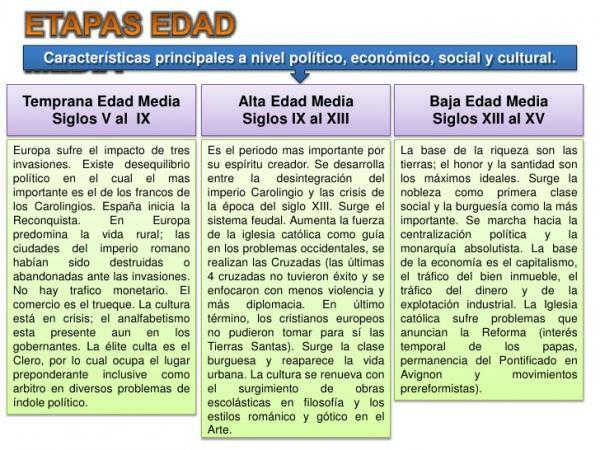
Image: Slideshare
The Modern Age: Main Characteristics.
The next historical epoch is the Modern Age It is divided from the discovery of America in 1492 until the beginning of the French Revolution. This is a period in which a strong evolution is beginning to be witnessed as inventions such as the printing press appear but, also, at the political-social level the discovery of America leads to a new way of seeing and understanding the world. During this time the cultural period known as the RenaissanceIn other words, he turned his eyes to the Classical era in order to follow its influence on an aesthetic and artistic level.
Since the end of the Middle Ages, cities had been growing and, therefore, presented a strong logistical and urban development. This fact made the economic system prevailing until then (feudalism) was transformed to give way to the capitalist system that is the one that governs to this day.
Most important events of the Modern Age
So that you can understand this age of history we are going to make a chronological summary of the most important events that took place in this period:
- Expansion of the bourgeoisie: this social class is consolidated in the Modern Age due to the growth of trade and industrial activity but they needed new buyers and, therefore, cities and countries began to open up to the world to buy and sell products. In that other lesson we discover you how the bourgeoisie arises.
- Expansion of businesses at sea: the Turks had blocked trade in the Mediterranean and, for this reason, commercial expansion had to be done by incursions into the sea. This was the reason why Columbus discovered America because he was looking for a commercial route to go to India.
- Piracy: Due to this commercial opening by the seas and oceans, piracy increases, that is, the presence of thieves who raided ships to loot them and take over the mutiny. Think that many of these ships came from doing business with other countries and, therefore, were full of both monetary and material wealth.
- New currents of thought: humanism and rationalism are imposed in the first part of the Modern Age, therefore, new currents arise philosophical that are inspired by the classics and in which man is once again the center of thought and debate philosophical. At the end of this historical period we find another current, the Enlightenment, an intellectual movement characterized by rationality.
- Increase in slavery: Due to the discovery of new lands, human slavery is increased, thought to be able to build new cities in the discovered world. The slaves, coming from Africa, move to the Spanish, French, Portuguese and English colonies in America creating authentic depopulation of African areas.
- Industrial Revolution: Thanks to the development of the industrial sector, machines began to be created to improve industrial processes and thus be able to satisfy the growing demand in the market. The capitalist system is beginning to be deeply felt in a society in which there are more and more middle classes with the ability to buy and manage their own economy.
Here you can access to consult the characteristics of the Modern Age most prominent.
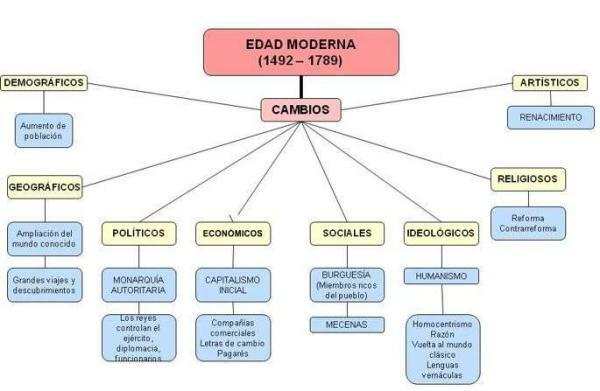
Image: Architecture, construction and decoration in ARQHYS.com
The Contemporary Age: Main Characteristics.
And we already entered the last of the ages of history talking about the Contemporary Age, that is, the current moment in which we live. The starting point must be sought at the beginning of the French Revolution, that is, in 1789 and continues to this day.
In this period, humanity has experienced strong social changes that have achieved very significant improvements in the quality of life. Among the characteristics of the Contemporary Age we highlight the following:
- A new system of government appears that has never appeared before: the republican system, that is, a form of government in which there is no king or sovereign who reigns over the country. The government is the people and its representative is established by popular vote; Currently, in the world there are republics such as France, Italy, and so on.
- Consolidation of capitalismas an economic system: during the Contemporary Age, capitalism has established itself as the most popular form of economic and social organization among most of the countries of the world. In this other lesson we bring you closer to a summary of the history of capitalism.
- Loss of Church power: capitalism and the new cultural currents (in which reason was the starting point) made that, little by little, the influence of the church and western religions were in decline.
- Demographic increase: the increase in population has been a constant in the Contemporary Age and, today, it is one of the greatest dangers that we face. The reason is no longer that we have many children (which is not the case) but that, thanks to advances in medicine and science, we die much later.
- Increased demand: because we are more and more people in the world, more basic products are needed to live and, therefore, industries have grown and natural resources are being overexploited.
- Appearance of great inventions that have revolutionized the world: the telephone, the steamship, the light bulb, the cinema, the plane, the Internet, and so on.
- Globalization phenomenon: the world is opened at a commercial and tourist level to be able to create relationships between other countries and, thus, large companies can create their pieces in underdeveloped countries (paying very little money for them) and sell them in First World countries, thus achieving wide Benefits.
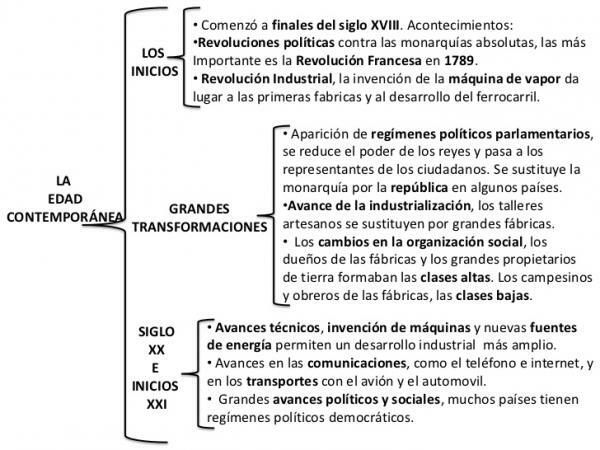
Image: Slideshare
Timeline of the ages of history.
By way of conclusion, and so that the concepts presented in this summary of the ages of history are better saved, we attach you here a timeline. In it, you can find a complete temporal division of our history that starts from prehistoric times and continues to the present day.
With this timeline you can visualize in an easier way and how time develops in our history and the most important events of each period.

Image: the faud library
If you want to read more articles similar to The Ages of History - Easy Summary!, we recommend that you enter our category of Story.
Bibliography
- Alvarez, R. V., González, S. G., de Toro Miranda, R. M., & Telechea, J. Á. S. (2004). Middle Ages. Ages: history magazine, (12), 81-144.
- Santos Yanguas, N. (1981). The conception of the history of Rome as a succession of ages in Latin historians. Classical philology notebooks.
- Schelling, F. (2002). The ages of the world (Vol. 9). AKAL editions.
- Yanguas, N. S. (1981). The conception of the history of Rome as a succession of ages in Latin historians. CFC (L), 17, 173-184.

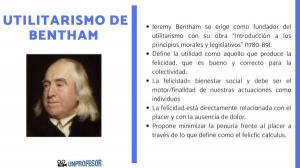
![12 characteristics of the SCULPTURE of Romanticism [with IMAGES!]](/f/312964d3e516925418e53a19e0990da7.jpg?width=300&height=200)
